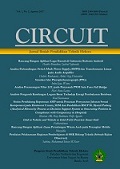Sea Surface Salinity with SMOS
DOI:
https://doi.org/10.22373/crc.v1i1.1378Keywords:
Sea Surface Salinity, SMOSAbstract
The mission to observe the Sea Surface Salinity (SSS) from the space is not really new because it has been started from long time ago. The first mission was the Skylab which used a 1.4 GHz microwave radiometer in 1970’s. But this mission is still not as comprehensive as other missions which observe such as Sea Surface Temperature (SST), Sea Surface Height (SSH), Ocean Color, and so on. Realizing the importance of SSS distribution in the ocean and its influences to the Earth’s climate system has motivated the scientists to develop a new technique in observing the SSS from space and lead a mission called the SMOS mission which was launched in November 2, 2011. Besides observing the SSS, this mission observes the Soil Moisture as well. The Soil Moisture and Ocean Salinity (SMOS) mission aims to obtain global and regular measurements on the soil moisture and the ocean salinity. These measurements are essential for climate and hydrological models, among other purposes. SMOS payload is a L band (21 cm, 1.4 GHz) 2D interferometric radiometer on a generic Proteus platform. The mission lifetime is at least 3 years (0.5 for commissioning and 2.5 for normal operation) + 2 years (extended operation) + 10 years for the post-mission processing. Raw physical data, level 1 and level 2 products will be produced by the PDPC (SMOS Payload Data and Processing Centre). It is an ESA center located in Villafranca (Spain) and operated under the responsibility of ESA. The SMOS Ocean Salinity objective is accuracy better than 0.1 psu, with 10 days to monthly grid scale (200 km).References
ESA (http://www.esa.int).
CERSAT (http://www.salinityremotesensing.ifremer.fr/activities/smos/data/l3).
Kerr et al. The SMOS Mission: new tool for monitoring key elements of the global water cycle. Proceedings of the IEEE, Washington. 2010
Swift C T. Passive Microwave Remote Sensing of The Ocean, Boundary-Layer Meteorology 18, USA. 1979
Yin et al. First analysis of SMOS sea surface salinity. 2010
Downloads
Published
2017-05-04
Issue
Section
Articles
License
Authors who publish in CIRCUIT: Jurnal Ilmiah Pendidikan Teknik Elektro agree to the following terms:
- Authors retain copyright and grant the journal right of first publication with the work licensed under a Creative Commons Attribution-ShareAlike 4.0 International License (CC BY-SA 4.0) that allows others to share and adapt the work with an acknowledgement of the authorship and initial publication in this journal
- Authors are able to enter into separate, additional contractual arrangements for the non-exclusive distribution of the journal's published version of the work (e.g., post it to an institutional repository or publish it in a book), with an acknowledgment of its initial publication in this journal.
- Authors are permitted and encouraged to post their work online (e.g., in institutional repositories or on their website) prior to and during the submission process, as it can lead to productive exchanges, as well as earlier and greater citation of published work. (See The Effect of Open Acces)

